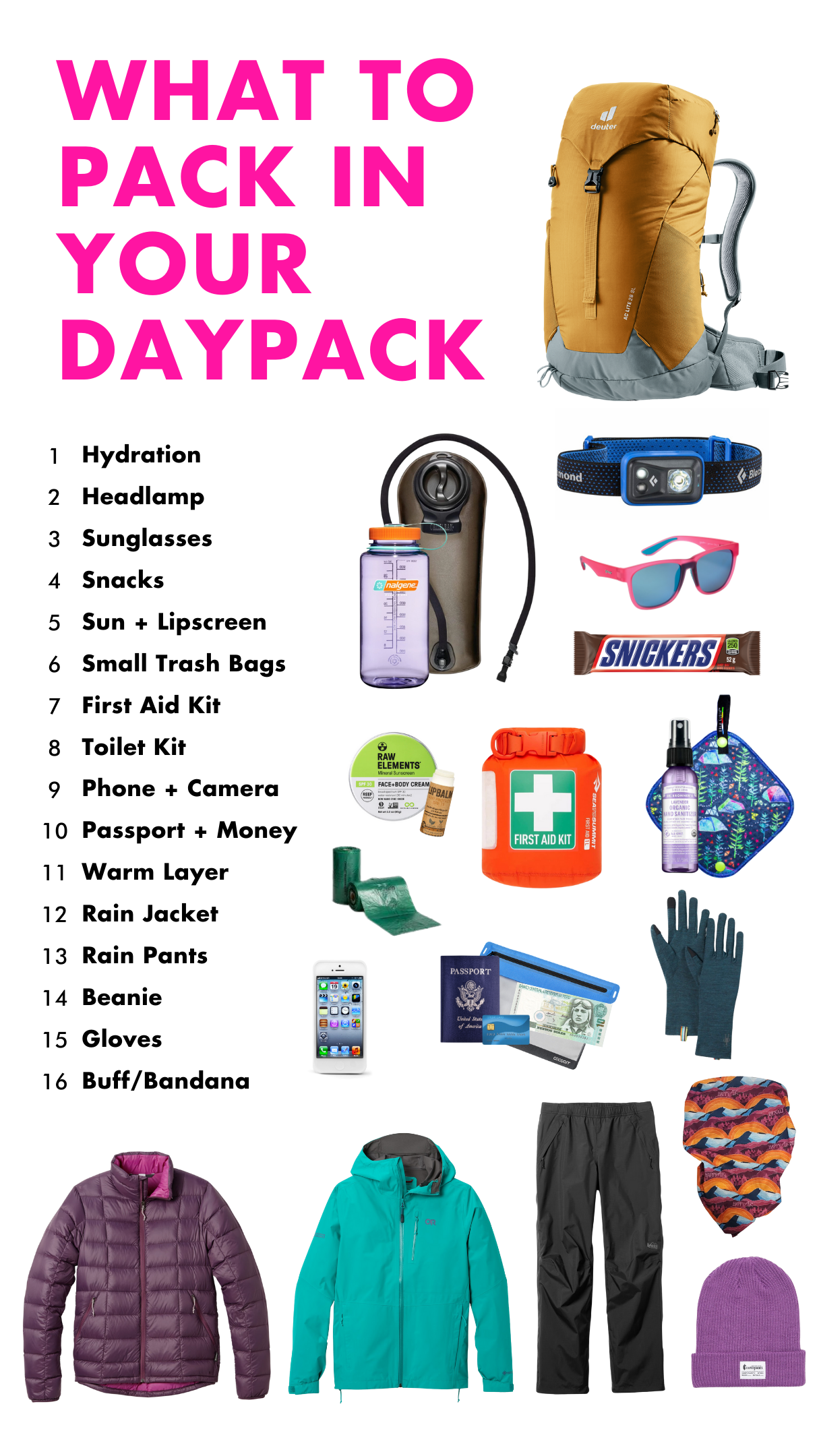At WHOA, we don’t believe in overpacking—but we definitely believe in being over-prepared. This guide is your no-BS checklist for the must-haves in your daypack every day whether you’re on a day hike, training, or on a multi-day trek. Think: protection, safety, sustenance and sustainability!
CLICK HERE to save this image on your phone, so you can use it on the trail!
Pack Like a Pro: Our Go-To Daypack List
16 ITEMS TO HAVE EVERY TIME YOU HIKE
1. Hydration
Staying hydrated on the trail is non-negotiable. A hydration bladder and/or water bottle ensures you can sip regularly and avoid dehydration, especially important at higher altitudes and in hot weather.
2. Headlamp
Whether you’re starting early, finishing late, or facing an unexpected delay, a headlamp keeps your hands free and your path lit — a small tool that can be a literal lifesaver. Pro tip: make sure it’s charged fully and/or that you have spare batteries.
3. Sunglasses
Protecting your eyes from UV rays and glare, especially at high elevations or on snow, is essential for both comfort and long-term eye health. We love Goodr polarized sunglasses because they are lightweight, durable and come in fun colors!
4. Snacks
Lightweight, high-energy snacks keep your energy up and your mood high during long stretches of trail time. Don’t just pack trail mix either; favorite snacks and candy go a long way for morale! (We love nerd clusters and cheez-its!)
5. Sun + Lipscreen
The sun’s rays hit harder the higher you climb. Protect your skin and lips with SPF to avoid burns, chapping, and long-term skin damage. As an added bonus Raw Elements has environmentally conscious products and packaging.
6. Small Trash Bags
Bring a few biodegradable or paper bags so you can pack out your trash - everything from banana peels to toilet paper. (Score extra karma points by picking up other people’s trash and leave wild places better than when you found them!)
7. First Aid Kit
A compact kit with essentials like band-aids, blister care, pain relievers, and antiseptic wipes can make a big difference in handling minor injuries quickly.
8. Toilet Kit
Nature calls, even on the trail. Pack toilet paper, biodegradable wipes and/or one of our faves, a Kula cloth, a small trowel (where necessary), hand sanitizer, and a zip bag for waste so you can practice Leave No Trace principles.
9. Phone/Camera
A smartphone can be your map, camera, safety tool, and connection to the world. Just don’t forget to keep it charged! If you’re not with a guide, make sure your device is GPS enabled for navigation and emergencies.
10. Passport and Money
If you’re trekking abroad or in remote areas, having ID and local currency on hand can be helpful.
11. Warm Layer
Weather can shift quickly, especially in the mountains. A fleece or puffy jacket keeps you insulated and warm if temperatures drop. We are also fans of the REI puffy vest because it is made of recycled materials and packs down small.
12. Rain Jacket/Poncho
A good rain jacket or poncho is your barrier against wind and wet. Essential for comfort, warmth, and keeping your pack contents dry. We like Outdoor Research because their rain jackets come in a wide range of sizes and stand up to the elements.
13. Rain Pants
Rain can drench your spirits — and your legs. Lightweight rain pants keep you dry and warm when the skies open up.
14. Beanie
You lose a lot of heat through your head. A beanie helps retain warmth during early morning cold starts, windy summits, and evening descents.
15. Gloves
Cold fingers make everything harder — from tying laces to taking photos. Lightweight gloves add serious comfort and dexterity when it gets chilly.
16. Buff/Bandana
Versatile, breathable, and tiny, a buff can be used as a neck warmer, face cover, headband, or even a towel. It’s a true multi-tasker every hiker should carry.
Looking for a great daypack? Something around 28-30 L should work perfectly for WHOA Adventures like Kilimanjaro and Peru. We love Deuter, Osprey, Gregory, and recommend making sure it’s compatible with a water bladder and hose and has a rain pack cover.
Some of the links on our site are affiliate links, and if you go through them to make a purchase WHOA will earn a small commission at no cost to you. That said, we only link to products that we truly love on the trails and brands we respect because of their quality and their values, not because of a kickback!








